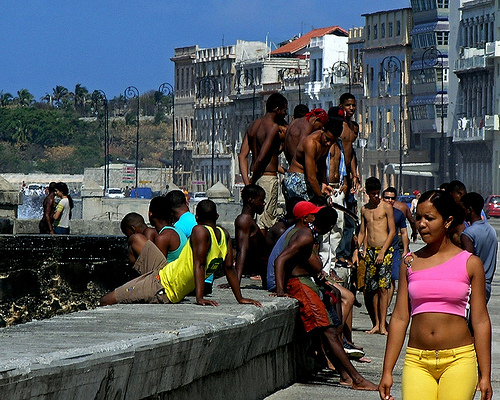
It’s the same place as a century ago. With the intense blue sea and calm of the Atlantic Ocean that surrounds it. A long strip of more than 8 kilometres of cement and concrete, with the lack of maintenance, falling apart in several sections.
It’s the Malecón. Meeting point of Habaneros. Of students who skip class and go swimming in dangerous and polluted waters. Of young people who can talk and listen to music freely. Territory of lovers. Rest-stop of Bohemians, drunks and nighthawks.
Wailing wall of strict syndicalists and party militants who at night, in the absence of recreational options, sit with their wives to speak of the children who fled 90 nautical miles away so as not to be like their parents.
Built in the early 20th century, the Malecón is the soul of Havana. The city has other symbols. El Morro y La Cabaña. The Giraldilla and the ceiba of the Temple. The Capitol and Paseo del Prado. The Cathedral and the cobbled streets of the colonial era. The Floridita and the Bodeguita del Medio. The stadium of Cerro and the Industriales team. El Vedado and its wide avenues and parks.
Havana, its people and its neighborhoods awake regret in millions of exiles. But the Malecón is the main thief of nostalgia for those who no longer live in the capital of all Cubans. So strong is this sentiment than an interview by Armando López with the actress Susana Pérez is entitled “The world starts on the wall of the Malecón”.
It has always been a wide walkway. With its own 24-hour life. In the morning and at night, in certain places, fishing rods and reels pretend to be able to catch a fish for dinner or to sell it at a good price.
It’s difficult. But the skilled fishermen, illegally, on rafts made from obsolete Russian truck tyres, row in the dark sea, and with hammocks and nets return with a string of edible fish. The amateurs will kill time and talk nonsense with their fishing colleagues.
There are other types of fishing. Exhausted hookers, in the early morning, sit on its wall as workers sleep, kick off their high heels and rub their feet after walking miles without ‘fishing’ a tourist with dollars or euros.
The length and width of the Malecón you can find sellers of melca, psychotropics and marijuana. Prostitutes with minuscule clothing try to stop cars rented by foreigners.
At any time you can see a troop of sellers, who evade the stringent budget instituted by the Government, dedicated to selling peanuts, pop corn and homemade candies for 5 cents. Or chicharrones of pork, hot tamales and bags of fried bonito at 25 cents.
To the disgust of those who used to take fresh air with children and families, certain areas have been occupied by transvestites, lesbians and fags. They are the “experts”, as they call themselves.
The police patrols with their new Chinese-made Gely cars usually look at them with contained repugnance, but they leave them alone. The order not to upset them comes from the very top. Mariela Castro, daughter of the number one, has said enough to the suppression of gays. And those, in Cuba, are big words.
Translated by: Araby
March 15 2011
